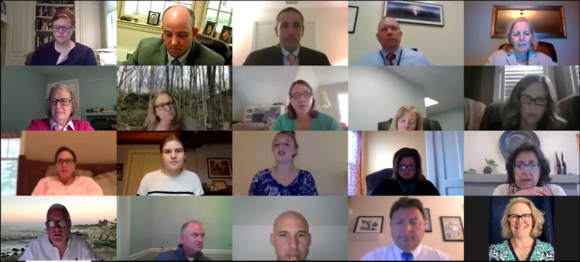
LYME/OLD LYME — The Lyme-Old Lyme (LOL) Board of Education (BOE) unanimously passed the proposed 2020-21 Regional District #18 budget of $34,711,631 during a virtual meeting Wednesday night.
After a reevaluation of savings from the current year, the 2020-21 budget now shows a decrease of $373,127 (1.06 percent) over the current (2019-2o) budget according to Ian Neviaser, Lyme-Old Lyme Schools Superintendent. There was a lively discussion among board members and the superintendent as to how to describe this decrease correctly, which BOE Chair Diane Linderman ended up declaring was, the biggest “negative increase” in the budget since 1973, when the regional district was formed.
Neviaser noted that a significant savings in the budget (5.5 percent) are due to a decrease in the need for special education programs for students as a handful of special needs students recently left the district.
“Our special education providers are currently doing an excellent job. The unknown factor in special education is always needs and new students,” said Neviaser. “This could wildly swing the other way tomorrow depending on enrollment.”
Neviaser also addressed some recent news articles, which discussed the school district’s recent savings, saying that, although some expenses have been saved due to COVID-19, that does not explain the whole picture. “Some of the savings that we’ve incurred have to do with the closure; for example we are not hiring substitutes right now,” said Neviaser. “As we’ve been saying throughout the entire year, the majority of our savings have come from special education.”
Due to the size of this year’s surplus, the project to resurface the six tennis courts on the main campus, which had been spaced over two years, will now be completed in the current financial year. Similarly, an additional project was also approved for waterproofing ($16,750.00) the exterior of the middle school’s split face cement blocks, which again had been included in the 2020-21 budget, but will now be moved into the current year.
Board member Rick Goulding, who chairs the Facilities Committee, mentioned there is a possibility that refinishing the high school gym floor might also be transferred into the current year’s budget. If it is decided to pursue that plan, he said that request will be made at the June BOE meeting.
Neviaser referenced the fact that the Gov. Lamont had recently declared that schools would remain closed for the remainder of the year. He stressed that he has been working closely with the Connecticut COVID-19 Reopening Task Force to maneuver the next steps in opening up school districts in a safe manner, however a timeline is still very broad at this point.
“We will look to them for some input. Knowing the way the state functions, they will provide general guidance and because every district is different, we will make our own internal adaptations based on that guidance,” said Neviaser.
Although a referendum in Lyme and Old Lyme is normally required in order to pass the school’s budget, this was not needed this year due to the Governor’s Executive Order 7I, which states that town and school districts were not required to vote on budgets by “any in-person budget adoption requirements.”
Neviaser noted that both towns would benefit significantly from the decreased LOL Schools’ budget when they finalized their town budgets in the upcoming weeks. He said Old Lyme will pay the school district exactly the same amount as in the 2019-20 budget and Lyme will pay 3 percent less than this year. The amounts the towns pay respectively of the total budget are determined by the relative percentages of students from each town, which are usually in a roughly 80:20 ratio with Old Lyme paying 80 percent of the budget. The numbers for the 2020-21 year saw Old Lyme increase its percentage of students while Lyme’s fell correspondingly.
Neviaser took a moment during the meeting to recognize Educator Appreciation Week, and share his appreciation for the efforts of all of the LOL faculty and staff during this unprecedented time.
“There is no single road map to make this work, it’s a constant adjustment and adaptation to whatever students need,” said Neviaser. “I think I speak for the full board that we greatly appreciate what they’re doing and how hard they’re working.”